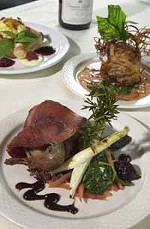Food Fetish
Aphrodisiac Edibles for Valentine's Day
By Rebecca Chastenet dé Gery, Fri., Feb. 14, 1997
 photo courtesy "Inter Courses - an Aphrodisiac Cookbook" |
Aphrodisiacs get their name from Aphrodite, the Greek goddess of love, and are by definition substances that stimulate or intensify our sex drive. The Chinese were perhaps the first to develop a passion for determining the aphrodisiac quality of different foods, and their culinary history is rich with recipes for libido-enhancing powders, salves, and potions. In China, edible aphrodisiacs such as ginger (which, incidentally, was shunned by the Puritans because it "heated the blood"), have been a preamble to sex for nearly 5,000 years. While modern science debunks much of the mystery behind these stimulating foods by informing us that most aphrodisiacs stir us sexually simply because they contain generous amounts of vitamins and minerals that contribute to the well-being of the body -- increasing our energy level and promoting good blood circulation -- physical form has earned a number of foods an alluring status as well. Throughout history, foods that resemble sexual organs have been said to possess seductive powers. Take the artichoke for example, valued by lovers in 17th- and 18th-century Europe. To savor its tender, tasty heart, a diner must pry open its tight outer leaves and delve deep inside its soft core -- a sexual analogy not lost on anyone.
While herbs and spices figure prominently among historically recognized aphrodisiacs -- the Phonecians and Greeks were partial to saffron because they claimed it stimulated the uterus and increased blood circulation. And many Arab cultures still value mint for the vim and vigor it imparts. A wide variety of fruits, vegetables, nuts, meats, and fish are also believed to harbor amorous properties.
Arousing Fruit
The ancient Greeks exhibited an affinity for figs, their supple texture and
pliable pinkish flesh likening them to the softer sides of femininity.
Pomegranates, with their abundance of seeds and tempting red juice, have long
stood as a symbol of fertility and desire in the Middle East. In fact, so
associated is the pomegranate with temptation, that some Biblical scholars
insist that the serpent lured Eve with it, not the ordinary apple. Even more common fruits, such as the peach, apricot, and banana, have connections to the erotic. Both peaches and apricots, with their soft, fuzzy texture and blushing pastel color, were appreciated by Asian and European nobles alike for their luscious, female quality. Today, one particularly unctuous French peach variety retains the name le sein de Venus, or Venus' breast. As for the banana, several groups inhabiting Central Africa are said to believe that the phallic fruit boosts virility in men, and the banana tree alone so powerful that its blossoms will fertilize those women who come into contact with them. (Sisters beware while vacationing in the tropics.) In Northern India, the land of the Kama Sutra, women treasure the coconut. So strongly is the fruit linked to fertility, that priests ceremoniously dole them out only to those women who wish to conceive immediately.
Tantalizing Vegetables
In the vegetable department, fennel is heralded as a source of sexual vigor in
men. Roman warriors reputedly munched on the bulb's ribs for strength and the
Kama Sutra prescribes the anise-flavored stalks as a cure for those lacking
gusto. The humble radish, consumed by the fatigued builders of the pyramids for
added energy, has been recognized as an aphrodisiac for centuries, its
astringent juice said to excite and warm the body. While the men of ancient
Greece reportedly munched on raw onion in hopes of increasing their longevity,
Venus was partial to carrots and asparagus, both vegetables said to provoke in
her great pleasure and delight. Asparagus also receives mention in Shaykh Umar
Ibn Muhammed Al Nefzawi's 16th-century book, The Perfumed Garden.
"Asparagus, with the yolk of egg fried in fat, camel's milk, and honey, causes
the virile member to be on the alert, night and day." (Good luck, gentlemen, in
securing the camel's milk.) More recently, 19th-century French gastronome
Brillat-Savarin lauded the costly truffle as the king of aphrodisiacs and it is
said that the diminutive Napoleon routinely feasted on the fungus prior to
copulation.
Luxurious Stimulants
When it comes to universally recognized aphrodisiacs, two luxury foods stand
out: oysters and caviar. Hedonistic feasts throughout history have typically
paired the glistening mollusks and velvety onyx eggs with champagne, and the
lavish tradition continues. Legend has it that Casanova slurped oysters on the
half-shell prior to his trysts. And even skeptic scientists concur that the
oyster has seductive powers, the result of its elevated zinc content. Zinc is
essential for the production of testosterone, they note, a hormone that spurs
the sexual appetite in both men and women. Caviar's aphrodisiac qualities are
perhaps less scientifically founded. Made from sturgeon eggs, caviar is simply,
if not surprisingly, believed to increase fertility.Game meats and beef also claim a place among libido-enhancing foods. In Europe of the Middle Ages, men were said to be best served by dining on the mighty stag or wild boar. Women, on the other hand, derived pleasure from game birds. Certain of the power of partridge, Henry IV of Navarre fed the bird to his mistress, Gabrielle d'Estrees, during foreplay. So convinced was Navarre of the partridge's potency, that he traveled to d'Estrees' home with his chef, who kept surplus supply of the birds on hand. Beef came to be regarded as an aphrodisiac much later in the West, although the Japanese and Chinese have long been privy to the bovine's powers, serving thin strips of beef blanketed with oyster sauce in a kind of "double whammie." In the US, rare steaks found favor in the early 1930s when they were said to assure increasing longevity, and the French's famous steak tartare may have been developed with the same purpose in mind.
Sweet Seduction
There's a reason chocolate is the favored Valentine's Day gift of lovers; the
rich, sweet confection is one of the strongest known aphrodisiacs. Chocolate
contains both caffeine, which stimulates the central nervous system, and a
natural amphetamine known as phenylethylamine. The Aztecs and Mayas both marked
the annual harvest of cacao beans with ongoing orgies, and offered the dark
pods to their gods at births, weddings, and puberty rites. Legend has it that
Montezuma, the leader of the Aztecs, derived his insatiable energy from the 50
cups of chocolate he drank daily in order to respond to the sexual demands of
his harem of 600. In the 17th century, English Royal Physician Henry Stubbs
formally issued an edict declaring chocolate "provocative to lust." For a sure-fire sexual pick-me-up, indulge in chocolate paired with nuts. The union is dangerously delicious as many nuts also boast aphrodisiac qualities. The Greeks and Romans favored walnuts, tossing them at newlyweds instead of rice; an ancient Latin medical text recommends hazelnuts as a cure for impotence, and pistachios wielded such power over the Queen of Sheba that she monopolized Syria's supply.
Tex-Mex Was Never So Sexy!!
Never considered our ordinary chiles, avocados, and black beans as the
building blocks of love? Well, think again. In their alluring new book
Intercourses, An Aphrodisiac Cookbook, ($24.95, hard, Terrace
Publishing), Martha Hopkins and Texan Randall Lockridge reveal the steamy side
to these seemingly ordinary ingredients. While Intercourses discusses
the standard aphrodisiacs, from herbs to the infamous oyster, and offers
recipes paired with enticing nude/food photos, their take on Tex-Mex is
particularly inspiring. Chiles, Hopkins and Lockridge say, are a
no-no for nymphomaniacs, as they
get the "blood rushing, the heart pumping, the face flushing, and the pores
sweating." Avocados, they explain, were referred to as "ahuacatl," or
testicle, by the Aztecs who considered the creamy fruit so powerful that
virginal maidens were restricted to their homes during its harvest. And black
beans, they note, were off-limits to nuns in the early Latin Church because of
their mysterious power to encourage procreation.
For a love-luring Tex-Mex Valentine's feast at home, try these stimulating recipes from Intercourses:
Spicy Grilled Shrimp
Juice and zest of 2 limes3 hot chile peppers, seeded and sliced
2 stalks lemongrass, outer leaves removed, sliced
1 2-inch piece ginger, grated
2 cloves garlic, crushed
2 tablespoons warm honey
6 tablespoons olive oil
1 tablespoon chopped cilantro
1 pound jumbo shrimp, shelled and deveined
Combine lime juice, zest, chiles, lemongrass, ginger, garlic, honey, olive oil, and cilantro in a bowl and mix well. Add the shrimp, coating well. Refrigerate for 4 hours. Thread on skewers. Grill over medium-high heat for approximately 5 minutes on each side; brush with marinade while cooking. Serves 2.
Sweet Bean Pudding
1 cup cooked black beans1 teaspoon grated orange zest
1/3 cup plus 1 tablespoon sugar
1 (14-oz.) can pure coconut milk
2 tablespoons water
Pinch of salt
3/4 cup short-grain white, Jasmine, or Arborio rice
1/2 teaspoon vanilla extract
6 banana leaves or 12 tamale husks
1 ripe banana, sliced in rounds
Mash the beans with orange zest and 1 tablespoon sugar in a small bowl. Set aside. Combine the coconut milk, water, sugar, and salt in a medium saucepan. Bring to a boil. Add the rice and reduce heat to medium. Cook for 12 minutes or until milk is absorbed and rice half-cooked, stirring frequently. Remove from heat, stir in vanilla, and allow to cool. Tear 1 banana leaf into 4 strips to use as "ties." Place another leaf on the work surface. Spoon 3 tablespoons of the rice mixture in the center, add 3 tablespoons beans. Place 3 rounds of banana on the beans and top with another 2 tablespoons rice. Fold the banana leaf around the mixture and tie a banana leaf strip around the package to secure. Repeat process for remaining packets. Boil water in a steamer pot. Add packets to a steamer rack over the boiling water. Steam, covered, for 45 minutes or until rice is tender. Cool and serve. Yields 5 servings.








